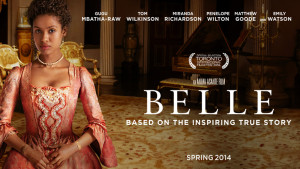Twitview: beautiful people tell a beautiful story about an ugly part of history. Gugu Mbatha-Raw is a new face to the US that’s on her way up. Grade: A
Here in America we tend to focus on our own battle with the institution of slavery. The Civil War, the Emancipation Proclamation, and Harriet Tubman. Nat Turner, Dred Scott and the Thirteenth Amendment. But what about across the pond? Belle takes a look at the beginnings of the abolitionist movement in England, through the eyes of a mixed-race woman that had the ear of the highest judge in the land. Because she was his great-grandaughter. And yeah, it’s a true story.
Dido Elizabeth Belle was born of a slave woman and Admiral Sir John Lindsay, and when Dido’s mother died Lindsay brought Dido to the home of his uncle, William Murray, Lord Mansfield. As Dido grew, so did the attachment the Murray family had to their “mulatto” relative. But English society was a cruel mistress, and Dido found herself in the odd position of being on the inside, looking in. Never being a part of society, due to her “exotic nature”, but otherwise having all the privileges of being to the manor born. Which, of course, was it’s own particular form of loneliness; “How may I be too high to dine with the servants, yet too low to dine with my family?”, she asks her great-uncle. Hold on to that queasy feeling of outrage for her; we’re getting to the meat of the film.
Murray begins to research a case that comes to his bench; the massacre of 132 African slaves on the ship The Zong. The owners of the slaves wanted recompense through insurance for their “property”. Murray, as Lord Chief Justice, had to rule on whether they’d get it. So Murray, and Dido — who Murray has tried his best to shield from the ugliness of the world — are thrust into the abolitionist movement, at the same time Dido and her cousin Elizabeth are making the rounds in society for suitable husbands. When Dido meets young frenchman — gasp! — John Davinier, her family fears a match between these two would not be good enough for Dido. But the Zong case has opened her eyes, and things begin to change for everyone.
Of course the film takes a few historical liberties here and there, but overall the story is a true one; Dido’s great-uncle William Murray was Lord Chief Justice of the King’s Bench (kinda like Chief Justice of our Supreme Court). Dido lived as a member of Murray’s household — and was most likely treated as family — during the Zong massacre and resulting legal case. And Murray’s decision, one that set in motion the abolishment of slavery in England, was most certainly influenced by the fact that he had a mixed-race great-niece that he adored.
During the film, Dido and Elizabeth sit for a portrait, which is unveiled at the end of Belle. The real historical portrait of Dido and Elizabeth looks unremarkable, and perhaps even a bit belittling; is that Dido in a turban? Whaaaat? But in the here-and-now we’ve got to remember that in their era, having a Caucasian and a “negro” with their eyes at the same level in the portrait? Unheard of until then. (And also, in those days womens’ turbans were très chic in upperclass English society.)
As a historical piece, there’s just enough true history to keep things kosher, but not enough to have anyone pass a final based on the knowledge presented here. As a fascinating look at a little-known aspect of black history? It’s worth it’s weight in gold. Belle doesn’t shy away from the harsh realities of life in the eighteenth century, complete with horrible bigots (played with just enough smarmy charm by Draco Malfoy Tom Felton and Rita Skeeter Miranda Richardson as members of the snobby but broke Ashford clan), Upstairs/Downstairs drama, and even in-family discomfiture.
It’s rare that a film made to tug on heartstrings has itself a sturdy heart. Credit the clear-eyed direction of Amma Asante, a solid script by Misan Sagay, and a breathtaking performance by Gugu Mbatha-Raw (Larry Crowne, Touch). Mbatha-Raw gives Dido a stiff backbone to go with that upper lip, and yet when she’s alone — particularly in a scene where after being snubbed she tries to rub the color off of her face — her humanity can break your heart. There’s also a fabulous chemistry between Mbatha-Raw’s Dido and Sam Reid’s Davinier. Wonderful character actor Tom Wilkinson (The Kennedys, Michael Clayton), as William Murray, Lord Mansfield, fleshes out a historical figure known for his work rather than his home life. Oscar winner Emily Watson plays Lady Mansfield, because this film obviously ascribes to the idea that if you fill the cast list with great talent, you’re gonna make a good film. And y’know what? They were right.


[…] Movie Review: Belle […]